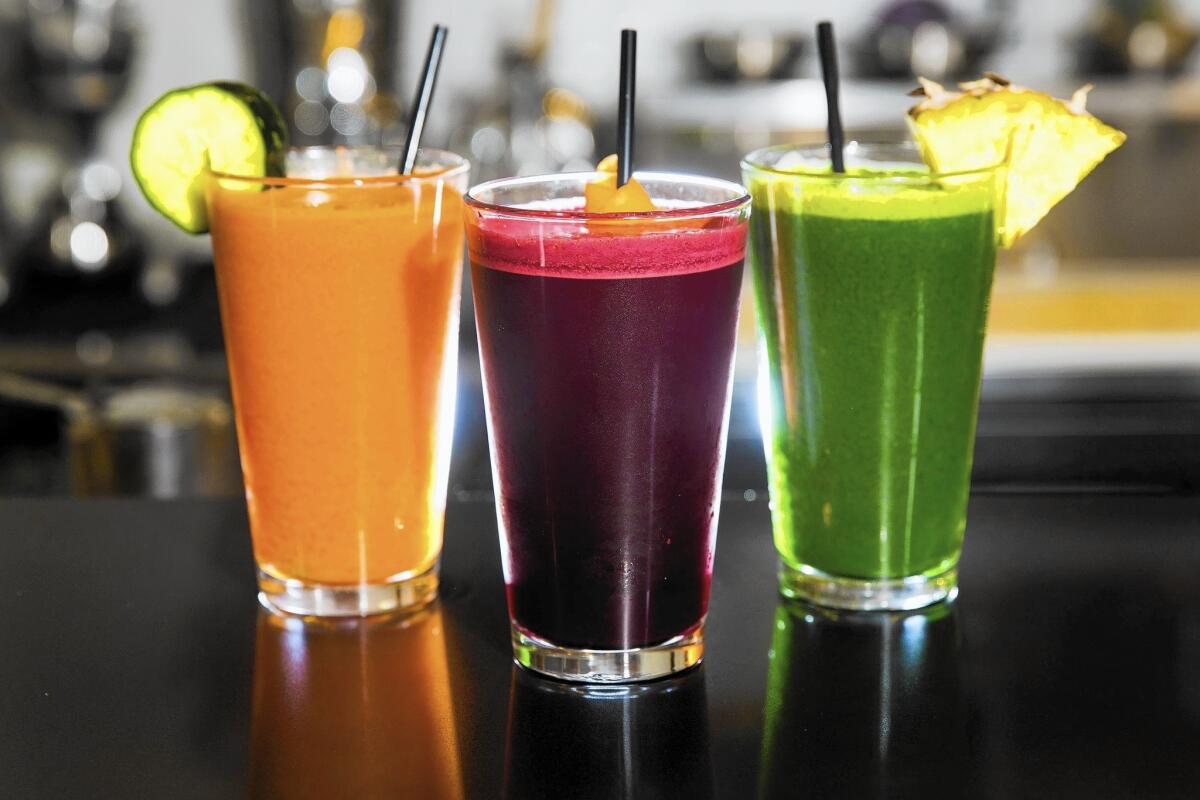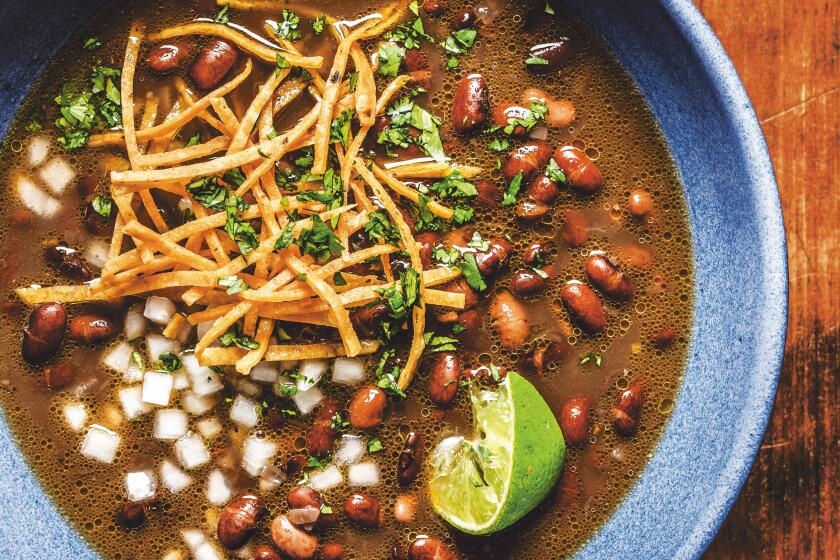Juicing trend still going strong in 2015

A year ago, trendistas were snuggling up to juice bars all over L.A. to cleanse, reset, detox and glow a little. Today, things are only busier in the world of juice — and I don’t mean Minute Maid. Juicing just won’t go away.
“The concept has settled into being just part of a healthy life, rather than a thing,” says Andrew Freeman of the AF&Co. restaurant consulting firm in San Francisco.
But a “thing” it remains. Juice bars have opened in such L.A. hot spots as the Ace Hotel downtown and in Highland Park, adding to the dozens of places where people are paying in the double digits (yes, you can pay $12 for a drink that’s not spiked with vodka) for a bottle of juice, albeit cold-pressed and organic in a range of pretty colors. Cold-pressed juice is even for sale in airports and at Trader Joe’s.
“It’s amazing, it’s amazing,” Dave Otto says one morning outside his pristine, tiny shop on Beverly Boulevard in Los Angeles. His business began in 1975 as the Beverly Hills Juice Club, an extension of his “quest for a perfect diet.” These days, he does 10 to 15 times the business he did then, he says.
The cold-pressed juice market is estimated at $100 million a year. What gives?
In a way, it’s the moral equivalent of an Egg McMuffin — fast and convenient — although the juice client would never venture into a fast-food shop.
Today’s juice — cold-pressed between plates, meaning no heat is used — is a great answer for busy people, says Alexis Schulze, co-founder and chief visionary officer of the Costa Mesa-based Nekter Juice Bar chain of 49 shops. “It’s accessible for people who try to get their fruits and vegetables in but who say, ‘I just don’t have time to sit down and eat a salad,’” she said over a glass of Toxin Flush, made with apple, ginger, lemon, parsley and spinach.
Are we really that busy? Apparently so.
Busy but also yearning, Otto says: “People are sick and tired of being sick and tired.”
Amanda Chantal Bacon, founder of Moon Juice, which has shops in Venice and Silver Lake, says people are taking their health into their own hands because they feel disappointed by conventional food and medicine.
“People have invested so much time and energy and hope in fat-free foods like SnackWells and $200 eye creams and pills to make you happy in your marriage. We gave it a really good effort,” she says, explaining that she became a juicer to guard her own health.
With names for concoctions like Glow, Purity or Goodness Greens, who wouldn’t want to drink up? There are seasonal flavors, such as pumpkin spice and cranberry-cinnamon, and more exotic ones. Juice Served Here, which has a handful of stores in the L.A. area, offers charcoal lemonade; Moon Juice sells Silver Strawberry with Mezotrace silver.
And with the possibility of greater energy, glowing skin, a clearer mind, a detoxified gut and more, who could refuse? Most people eat so little plant food, says Joe Cross, author of “The Reboot With Joe Juice Diet, “is it any wonder that when they add these supercharged flood of nutrients that they feel better?”
But it’s hard to prove that glowing skin, clearer thinking or resetting is the result of juicing. And there’s plenty of disagreement about the value of a 16-ounce juice, even one made from up to 2 pounds of produce, compared with the food itself.
Lisa Sussman writes in her book “Cold Press Juice Bible” that the “jury is still out on whether your body can absorb the nutrients more easily in liquid form or if there’s any advantage in giving your digestive system a break from working on fiber.”
Dana Hunnes, a senior dietitian at the Ronald Reagan UCLA Medical Center, says she’s asked often about juicing. “I think it’s healthier to eat the food and get the fiber and other things,” though she says there’s likely no harm in jump-starting an effort to eat healthfully with a one-day juice regimen.
While many juices contain kale or spinach and other vegetables and herbs, they often also contain apples and other sweeter produce. And that can mean a fair amount of sugar.
To counter that, Sussman suggests juicing four servings of leafy or cruciferous vegetables for every one of fruit. (Of course, juicing at home takes a commitment ranging from $100 to $2,500 for the juicer.)
“Successful long-term juicers learn to liquefy greens and vegetables on a daily basis and to juice sweet-tasting fruits and the sweetest root vegetables ... in moderation,” Eric Helms writes in “The Juice Generation,” which is also the name of his New York company.
Whether organic cold-pressed juices are healthful depends in part on the context, says Tricia Psota, a nutritionist at the U.S. Department of Agriculture.
If juice is an addition to your diet, the calories can add up (a 16-ounce bottle typically has about 200 calories). So can the dollars. On the other hand, if a juice replaces your usual midmorning doughnut, it’s hard to argue against it.
Juice fans are not flinching, Freeman says. “They’re willing to pay for quality, to be in the know. We’ve come a long way from Tang.”
More to Read
Eat your way across L.A.
Get our weekly Tasting Notes newsletter for reviews, news and more.
You may occasionally receive promotional content from the Los Angeles Times.











